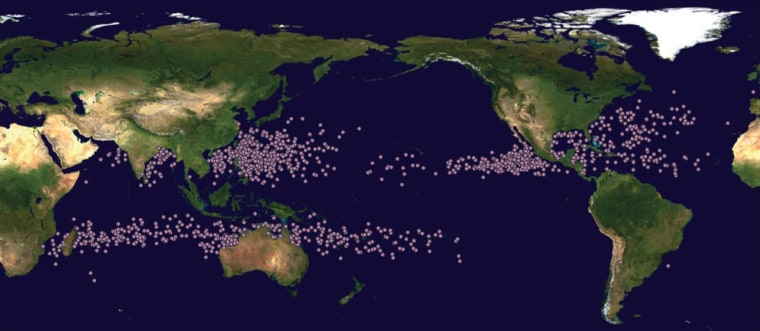Hurricanes and typhoons at their peak intensities are shifting away from the equator and towards the poles, scientists reported Wednesday, potentially placing coastal areas that are unaccustomed to deadly storms in their path if the trend continues.
Satellite data going back to 1980 show a global average shift of about 35 miles each decade on both sides of the equator, the experts announced in the peer-reviewed journal Nature.
This “pronounced poleward migration” means “potentially profound consequences for life and property” if the trend continues, according to the scientists from the National Oceanic and Atmospheric Administration and the Massachusetts Institute of Technology.
There is an interesting caveat: A shift was not seen in the North Atlantic.
But that doesn’t negate the global trend and there’s a good chance other factors are at work in the Atlantic, study lead author Jim Kossin, a scientist at NOAA’s National Climatic Data Center, told NBC News.
“The Atlantic has these other forces acting on it” when it comes to hurricane formation, he noted, among them strong ocean circulations and reduced aerosol pollution in the region.
Those other forces could be masking the poleward shift, he said, “but that doesn’t mean they’re going to last indefinitely. It’s unwise to just simply say, ‘It’s not happening in the Atlantic and therefore it will not.'"
"The Pacific Ocean regions combined account for more than 50 percent of global tropical cyclone activity, so poleward trends there over the past 30 years have contributed strongly to the global trend."
And the global effect still stands due to the pronounced shift in the Pacific Ocean, noted Hamish Ramsay, a climate scientist who wrote a companion article in Nature about the changes.
“The North Atlantic is a big chunk of ocean, but tropical cyclones there account for only about 14 percent” of the total, Ramsay told NBC News.
“The Pacific Ocean regions combined account for more than 50 percent of global tropical cyclone activity, so poleward trends there over the past 30 years have contributed strongly to the global trend,” said Ramsay, a researcher at Australia’s Monash University.
The poleward migration follows earlier studies showing an expansion during the same time period of the tropics, the area along the equator defined by warm, humid weather.
The tropical expansion appears to be shifting poleward two key ingredients for hurricanes and typhoons, the experts said.
One is a decrease in what’s called “vertical wind shear” -– the difference between wind speeds in the upper and lower troposphere. Scientists know that a weaker wind shear helps storms form and intensify.

The second ingredient is an increase in what’s known as “potential intensity” –- how strong a storm could become given local sea and air temperatures, as well as humidity.
For Kossin, the key takeaway is that scientists should double down on figuring out what’s driving the expansion of the tropics because that seems to hold the key to stopping, or at least slowing, the shift of big ocean storms to new areas.
The tropics’ expansion has been linked to manmade problems: ozone depletion, air pollution and greenhouse gases tied to global warming, Kossin noted. But figuring out to what extent each plays a role is needed before finding a fix.
“There’s more work required to better understand what’s causing this,” he said.
By showing that the tropics’ expansion seems to also be shifting hurricanes and typhoons, the new study aims to “galvanize further work,” Kossin said.
The potential for hurricane and typhoon threat to new areas, he said, “certainly heightens the interest” in what’s expanding the tropics.